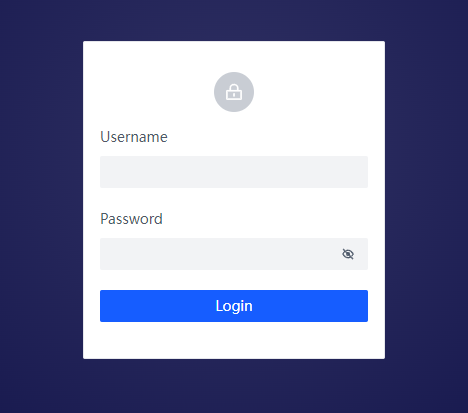Authentication
In over 90% of cases, a backend service requires authentication, especially since most backend operations directly manipulate the database. Naturally, tushan provides a well-packaged login logic.
You need to prepare an authProvider to inform tushan how to handle the login process.
<Tushan
authProvider={authProvider}
>
</Tushan>

The interface definition for authProvider is as follows:
import { AuthProvider } from 'tushan';
const authProvider: AuthProvider = {
login: params => Promise.resolve(/* ... */),
checkError: error => Promise.resolve(/* ... */),
checkAuth: params => Promise.resolve(/* ... */),
logout: () => Promise.resolve(/* ... */),
getIdentity: () => Promise.resolve(/* ... */),
handleCallback: () => Promise.resolve(/* ... */), // for OAuth2
getPermissions: () => Promise.resolve(/* ... */),
};
Quick Start
Tushan also offers a built-in generic authentication creation function.
import { AuthProvider, createAuthProvider } from 'tushan';
const authProvider: AuthProvider = createAuthProvider({
loginUrl: '/api/login',
});
The configuration parameter loginUrl indicates the URL address of the login interface.
The specific backend login logic needs to be implemented on your own. The interface should return the following content:
{
"username": "string",
"token": "string", // for inclusion in subsequent request headers
"expiredAt": "number" // timestamp
}
The returned content will be stored in localStorage under authStorageKey (default is "tushan:auth"). You can retrieve the token from there for inclusion in the headers of subsequent HTTP requests.
Correspondingly, you can use the createAuthHttpClient function to create a httpClient that includes the token in requests.
const dataProvider = jsonServerProvider(
config.dataProvider.url,
createAuthHttpClient()
)
Including Token in Requests
To include the token in requests, you need to modify the request function used for sending requests.
Here is a simple example:
import { fetchJSON } from 'tushan';
const authStorageKey = 'tushan:auth';
const httpClient: typeof fetchJSON = (url, options = {}) => {
try {
if (!options.headers) {
options.headers = new Headers({ Accept: 'application/json' });
}
const { token } = JSON.parse(
window.localStorage.getItem(authStorageKey) ?? '{}'
);
(options.headers as Headers).set('Authorization', `Bearer ${token}`);
return fetchJSON(url, options);
} catch (err) {
return Promise.reject();
}
};
const dataProvider = jsonServerProvider('/admin/api', httpClient);
fetchJSON is a simple wrapper around the native fetch method.
Node Example
Login
Here is an example of a login middleware for a Node Express service. Implementations in other languages can be adapted accordingly.
const adminAuth = {
username: process.env.ADMIN_USER,
password: process.env.ADMIN_PASS,
};
router.post('/api/login', (req, res) => {
if (!adminAuth.username || !adminAuth.password) {
res.status(401).end('Server not set env: ADMIN_USER, ADMIN_PASS');
return;
}
const { username, password } = req.body;
if (username === adminAuth.username && password === adminAuth.password) {
// Username and password are correct, return a token
const token = jwt.sign(
{
username,
platform: 'admin',
},
authSecret,
{
expiresIn: '2h',
}
);
res.json({
username,
token: token,
expiredAt: new Date().valueOf() + 2 * 60 * 60 * 1000,
});
} else {
res.status(401).end('username or password incorrect');
}
});
This defines a /api/login interface that performs a simple check of the username and password. If they match, a JWT token is issued, and the relevant information is returned to the frontend.
Authentication
Here is an example of an authentication middleware for a Node Express service. Implementations in other languages can be adapted accordingly.
import type { NextFunction, Request, Response } from 'express';
import jwt from 'jsonwebtoken';
const adminAuth = {
username: process.env.ADMIN_USER,
password: process.env.ADMIN_PASS,
};
const authSecret = 'any-string';
export function auth() {
return (req: Request, res:
Response, next: NextFunction) => {
try {
const authorization = req.headers.authorization;
if (!authorization) {
res.status(401).end('not found authorization in headers');
return;
}
const token = authorization.slice('Bearer '.length);
const payload = jwt.verify(token, authSecret);
if (typeof payload === 'string') {
res.status(401).end('payload type error');
return;
}
if (payload.platform !== 'admin') {
res.status(401).end('Payload invalid');
return;
}
next();
} catch (err) {
res.status(401).end(String(err));
}
};
}
This uses a single-user mode, retrieving the username and password from environment variables. It then verifies the token carried in the request Header with the server's secret key using JWT, ensuring the user's token is valid.
Requests can be authenticated as follows:
router.use(
'/users',
auth(),
(req, res) => {
// ....
}
);